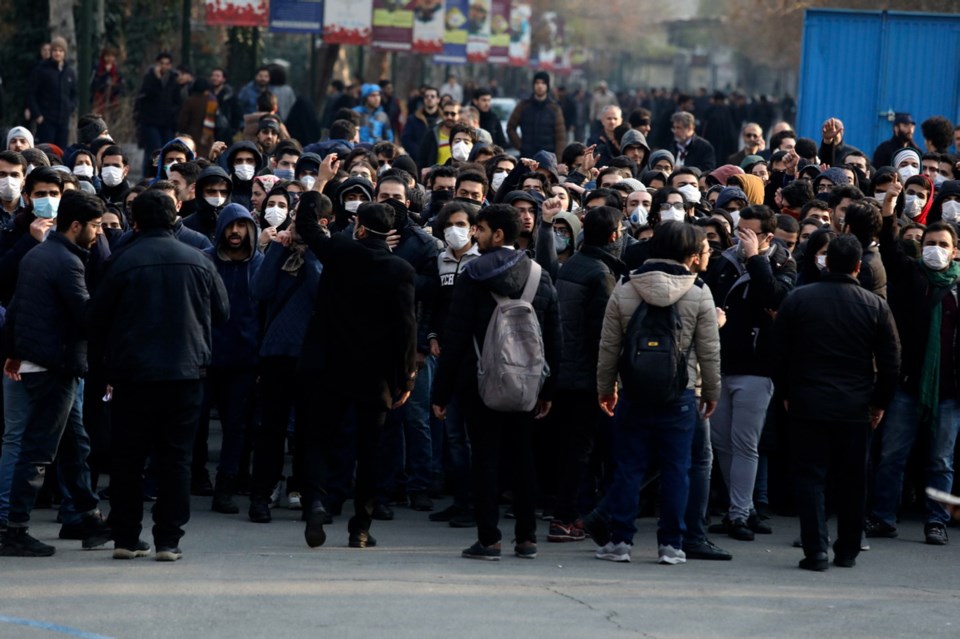In Canada, the downing of Flight 752 triggered waves of grief and anger, followed by watching and waiting. In Iran, the fallout is taking a far more dramatic course, as people take to the streets, fanning speculation of regime change in a country that has defied predictions for decades.
With protests spreading to at least a dozen cities, Canadians may wonder if the aftermath will push Iran to the edge. Will we, by our involuntary sacrifice, be the unwitting agents of regime change?
The iron grip of Iran’s theocracy runs deep — thanks not only to its network of mosques and militias, but the money that knits it all together. The clerical establishment and its close allies are heavily invested in every aspect of Iranian life, and they will fight to the death to protect their livelihoods.
Ever since the U.S. embassy hostage crisis in 1979, and the terrorist attacks Tehran fomented against soft targets around the world, the foreign image of Iran has been of an outlier and outlaw nation.
But Iran sees itself as a great civilization and erstwhile Safavid empire, a Persian military dynasty with an enduring cultural legacy.
Today’s Persians are more prone to see themselves as victims rather than perpetrators. On my past assignments to Iran, I almost always heard the pre-eminent refrain of Iran’s victimhood — the 1953 western-backed coup that displaced its democratic government and installed the Shah’s rule, and western sympathy for Saddam Hussein when his Iraqi forces launched a brutal eight-year war against them.
When President Donald Trump boasted that the U.S. had killed Revolutionary Guards commander Qassem Soleimani, and then tweeted that 52 Iranian sites were targeted, including those of cultural significance, Iran’s President Hassan Rouhani tweeted back at him: “Those who refer to the number 52 should also remember the number 290. #IR655.”
Rouhani’s numerical reference was to another catastrophic downing of a civilian airliner in the fog of war, when the American missile cruiser USS Vincennes blew up Iran Air Flight 655, killing all 290 people on board in 1988, never forgotten by Iranians.
But Iran’s president lost that trump card last week when his own Revolutionary Guards shot down Flight 752, a plane filled mostly with his own people and our own people.
Iran’s government was no longer victim but victimizer. Iranians who have long chafed under repression were suddenly joined by sympathizers of the regime who had suddenly lost faith in their country’s enduring narrative.
Their anger was directed not merely at the powerful Revolutionary Guards who mistakenly targeted a civilian airliner, nor solely at the authorities who recklessly kept Tehran’s airspace open to civil aviation after launching a missile attack against U.S. forces based in Iraq as their air defences were on hair-trigger alert, but most especially at the political leadership that denied the reality of what happened for three days, despite the obvious evidence.
They knew the truth from the start, but have lived a lie for so long. Since the 1979 revolution, Iran has relied on guerrilla forces — notably their secretive Quds Force and the proxy fighters in Lebanon’s Hezbollah — to aggressively wage asymmetrical warfare across the Middle East and the world, while deceptively playing the victim card.
But the latest deception has yielded the greatest disruption. With so many once again demonstrating in the streets, the regime will stop at nothing to crush the dissent, for it has too much to lose.
Human-rights groups say as many as 1,500 civilians were shot dead in economic protests late last year.
In 2009, the government cracked down violently against unarmed democracy-rights activists who dreamed of a so-called Persian Awakening after a disputed presidential election.
The cycle of repression continues because so many people have a vested interest in the regime’s resurgence. Defeating the power structure is so difficult because it is so dispersed — spread between Supreme Leader Ayatollah Ali Khameini, the Guardian Council that advises him, the Revolutionary Guard that answers to him, the basij militia that obeys him, the armed forces, the majlis of legislators, the presidency, the rival security services, and the Expediency Council that brokers power.
Above it all are the bonyads, semi-private foundations that acquired the deposed Shah’s assets and whose glorified slush funds account for a major part of the economy’s cash flow, lubricating the regime’s loyalists.
Like repressive regimes elsewhere, Iran is no pushover. When I covered the early stirrings of democracy in the late 1990s under then-president Mohammad Khatami, the prospect of incremental change held promise; the nuclear deal brokered more recently by Trump’s predecessor, Barack Obama (with assistance from Canada), might have returned Iran to the path of engagement, or at least denuclearization.
Now, the violent regime change that many outsiders hope for remains a remote prospect and an explosive one. It would not only be disruptive, but destructive — more likely to create chaos than lead to liberation.
Martin Regg Cohn is a columnist for the Toronto Star.



